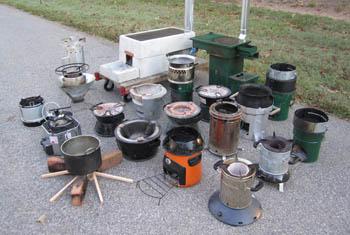Household Energy and Clean Cookstove Research

Problem
According to the World Health Organization, smoke from energy generated in households by cooking, heating and lighting is a major contributor to indoor air pollution in the developing world causing 3 to 4 million premature deaths annually and a wide range of illnesses.
Nearly 3 billion people in the world still depend on the burning of biomass (wood, charcoal, crop residues, and dung) and coal in rudimentary stoves or open fires to meet basic needs for household energy. People in the developing world, primarily women and children, are exposed to smoke with high concentrations of pollutants such as fine particles composed of toxic compounds. Approximately a half a million people in the U.S. are affected by indoor air pollution from poorly ventilated stoves, and household air pollution generated in Asia effects air quality in the U.S., especially in western states.
Health studies show that exposure to household smoke contributes to a wide range of illnesses such as pneumonia and low-birth weight in children, lung cancer, chronic obstructive pulmonary disease, blindness, and heart disease in adults, especially women who are disproportionately exposed in their homes.
Household Energy Research
EPA is an international leader in household energy research and provides independent scientific data on stove emissions and energy efficiency to support the development of cleaner sustainable technologies.
Laboratory testing is being conducted at EPA's household energy test facility in Research Triangle Park, NC. The facility has state-of-the-art measurement capabilities to characterize emissions of gases and aerosols, including toxic air pollutants, greenhouse gases, and black carbon.
Studies are conducted using multiple stoves and fuels tested under varying conditions to simulate operating conditions found in the field. EPA also sponsors and supports field testing.
EPA also conducts studies to understand the health effects from exposure to emissions from cookstoves.
Impact
EPA's research is making a significant contribution to providing cleaner household energy technology throughout the world.
As part of this effort, EPA supports development of standard cookstove testing methods and protocols through ISO Technical Committee 285, Clean Cookstoves and Clean Cooking Solutions. Standards provide incentives for stove developers to innovate and improve stove performance.
The work is supporting the Clean Cooking Alliance, which has a goal to achieve universal access to clean cooking solutions.
Investors, donors, and governments are seeking out the independent data to make decisions about clean cookstove programs. The science is providing information to cookstove developers and manufacturers to advance clean cookstove technology. EPA helps to support international Regional Testing and Knowledge Centers, many of which are sponsored by the Clean Cooking Alliance. The Centers are building capacity for evaluating stoves following international standards.
The scientific contributions by EPA are:
- Improving the health of people in the developing world
- Addressing environmental problems with cookstoves such as deforestation when wood is sought for burning
- Addressing emissions of black carbon and greenhouse gases that contribute to climate change.
- Improving air quality in the U.S.
Related Resources
Key Links
- EPA STAR grant publications
- Clean Cooking Alliance EXIT
- ISO Technical Committee 285, Clean Cookstoves and Clean Cooking Solutions EXIT
Highlighted Scientific Journal Articles
Ebersviller, SM, Jetter JJ. Evaluation of performance of household solar cookers. Solar Energy. Vol. 208, Pp.166-172. 2020.
Champion WM, Warren SH, Kooter IM, Preston W, Krantz QT, DeMarini DM, Jetter JJ. Mutagenicity- and pollutant-emission factors of pellet-fueled gasifier cookstoves: Comparison with other combustion sources. Science of the Total Environment. 20 May 2020. Exit
Du W, Zhu X, Chen Y, Liu W, Wang W, Shen G, Tao S, Jetter J. Field-based emission measurements of biomass burning in typical Chinese built-in-place stoves. Environmental Pollution. Vol. 242, Pp. 1587-1597. 2018Exit
Xie M, Shen G, Holder AL, Hays MD, Jetter JJ. Light absorption of organic carbon emitted from burning wood, charcoal, and kerosene in household cookstoves. Environmental Pollution. Vol. 240, Pp. 60-67. 2018.Exit
Shen G, Hays MS, Smith KR, Williams C, Faircloth JW, Jetter JJ. Evaluating the Performance of Household Liquefied Petroleum Gas Cookstoves. Environmental Science & Technology. Vol. 52, Pp. 904–915. 2018.Exit
Gibbs-Flournoy EA, Gilmour MI, Higuchi M, Jetter J, George I, Copeland L, Harrison R, Moser VC, Dye JA. Differential exposure and acute health impacts of inhaled solid-fuel emissions from rudimentary and advanced cookstoves in female CD-1 mice. Environmental Research 161. Pp. 35-48. 2018.Exit
Shen G, Preston W, Ebersviller SM, Williams C, Faircloth JW, Jetter JJ, Hays MD. Polycyclic aromatic hydrocarbons in fine particulate matter emitted from burning kerosene, liquid petroleum gas, and wood fuels in household cookstoves. Energy & Fuels. 2017.Exit
Mutlu E, Warren SH, Ebersviller SM, Kooter IM, Schmid JE, Dye JA, Linak WP, Gilmour MI, Jetter JJ, Higuchi M, DeMarini DM. Mutagenicity- and pollutant-emission factors of solid-fuel cookstoves: comparison to other combustion sources. Environmental Health Perspectives. 2016.Exit
EPA Reports
Jetter, J; Ebersviller, S. "Test Report - BioLite HomeStove with Wood Fuel - Air Pollutant Emissions and Fuel Efficiency," U.S. Environmental Protection Agency, Washington, DC, ORD-010644, 2016.
Life Cycle Assessments
Life Cycle Assessment of Cooking Fuel Systems in India, China, Kenya, and Ghana. Morelli B, Cashman S, Rodgers M. EPA/600/R17/225, 2017.
Life Cycle Assessment of Cookstove Fuels in India and China. Cashman S, Rodgers M, Huff M, Feraldi R, Morelli B, Thorneloe SA. U.S. Environmental Protection Agency, Washington, DC, EPA/600/R-15/325, 2016.
